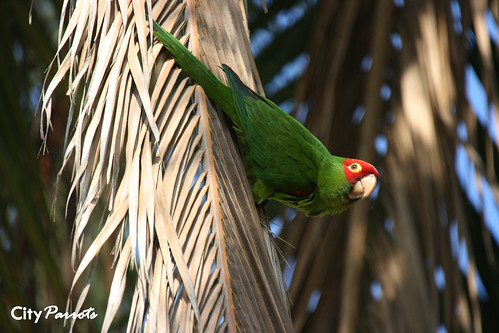Distinguishing between two birds of a feather
 Thursday, August 7, 2008 at 10:19
Thursday, August 7, 2008 at 10:19  Red-masked / Cherry headed parakeet (Aratinga erythrogenys)
Red-masked / Cherry headed parakeet (Aratinga erythrogenys)
The bird enthusiast who chronicled the adventures of a flock of red-headed conures in his book "The Wild Parrots of Telegraph Hill" knows most of the parrots by name, yet most of us would be hard pressed to tell one bird from another. While it has been known for a long time that we can become acutely attuned to our day-to-day environment, the underlying neural mechanism has been less clear.
Now a collaboration between researchers at the Salk Institute for Biological Studies and Weill Cornell Medical College has revealed that brain cells processing visual information adjust their filtering properties to make the most sense of incoming information.
"We are best at discriminating the facial features that are typical of our neighbors, and if they happen to be parrots, we become very good at recognizing individual birds," explains Tatyana Sharpee, Ph.D., an assistant professor in the Laboratory for Computational Biology and the lead author on the current study, which has been published in the August 5 online edition of the Journal of Computational Neuroscience.
Neurobiologists are on a perennial quest to understand how the brain codes and processes information. In the past, they had to rely on simplified objects on a computer screen or random stimuli to garner information on how the brain's visual circuitry works. "Ultimately we are interested in what happens in a natural environment," explains Sharpee, "but some questions require more control over the properties of visual stimuli than a picture of a natural scene would allow."
Neurons in the primary visual cortex only respond when a stimulus appears within a window covering a small part of the visual field that the eye sees. This window is known as the neuron's "receptive field." Whenever a stimulus enters the neuron's receptive field, the cell produces a volley of electrical spikes, known as "action potentials" that can be recorded.
But these neurons don't react to just anything. Instead they are highly specialized and can only "see" a single attribute such as color, motion, or a specific luminance pattern. By measuring a certain neuron's action potentials in response to random visual stimuli the researchers can infer the profile of its receptive field.
But growing evidence hints that this simple picture is incomplete. "The response of individual neurons can be strongly influenced by simple stimuli in the surround of the receptive field, a phenomenon known as contextual modulation," explains Sharpee.
To unveil how contextual modulation shapes the apparent profile of neurons specialized in recognizing luminance patterns, Sharpee teamed up with Jonathan D. Victor, Ph.D., Fred Plum Professor of Neurology and Neuroscience at Weill Cornell Medical College in New York. The study made use of two sets of visual stimuli that were first introduced to neurophysiology by Victor. These stimuli matched in size, contrast, and luminance but differ in higher-order statistics leading to oriented checkerboard-like patterns in one case and pinwheel patterns in the other (see image). Single neurons' responses to individual patterns were recorded in Victor's laboratory.
Using complementary methodologies developed by the two authors, who are leaders in applying information theory to extract meaning from a cacophony of signals, they then parsed the code for systematic, context-dependent changes in the neurons' responses. Maybe not surprisingly, they found that larger receptive field components were more susceptible to contextual modulation and adjusted more than smaller ones.
But more importantly, they discovered that odd-symmetric components induced systematic changes across the whole population of neurons in the V1 area of the visual cortex, whereas even-symmetric components did not.
Odd-symmetric components are patterns that turn into their opposite when rotated by 180 degrees, such as a white and a black bar that are arranged parallel to each other. Even-symmetric components (such as a white bar sandwiched between two black bars) remain unchanged with this rotation.
"Context is an important part of how we perceive visual stimuli," says Sharpee, "and these results show how individual neurons might adjust their properties in different natural environments, such as on a beach or in a forest."
The research was supported by a grant from the Swartz Foundation and the National Institutes of Health.
The Salk Institute for Biological Studies in La Jolla, California, is an independent nonprofit organization dedicated to fundamental discoveries in the life sciences, the improvement of human health and the training of future generations of researchers. Jonas Salk, M.D., whose polio vaccine all but eradicated the crippling disease poliomyelitis in 1955, opened the Institute in 1965 with a gift of land from the City of San Diego and the financial support of the March of Dimes.
 Aratinga erythrogenys - Red-masked Parakeet | in
Aratinga erythrogenys - Red-masked Parakeet | in  Research
Research 
